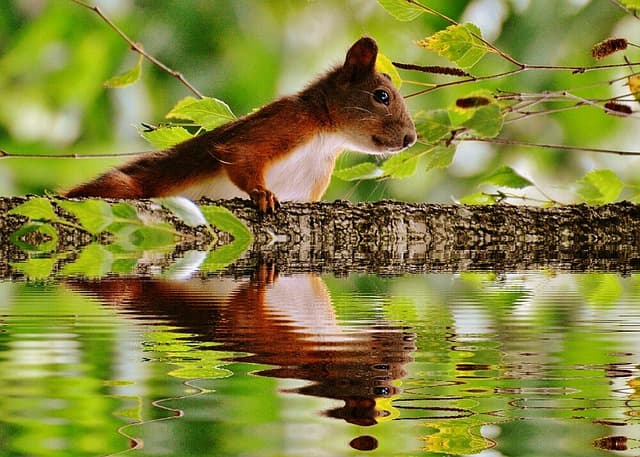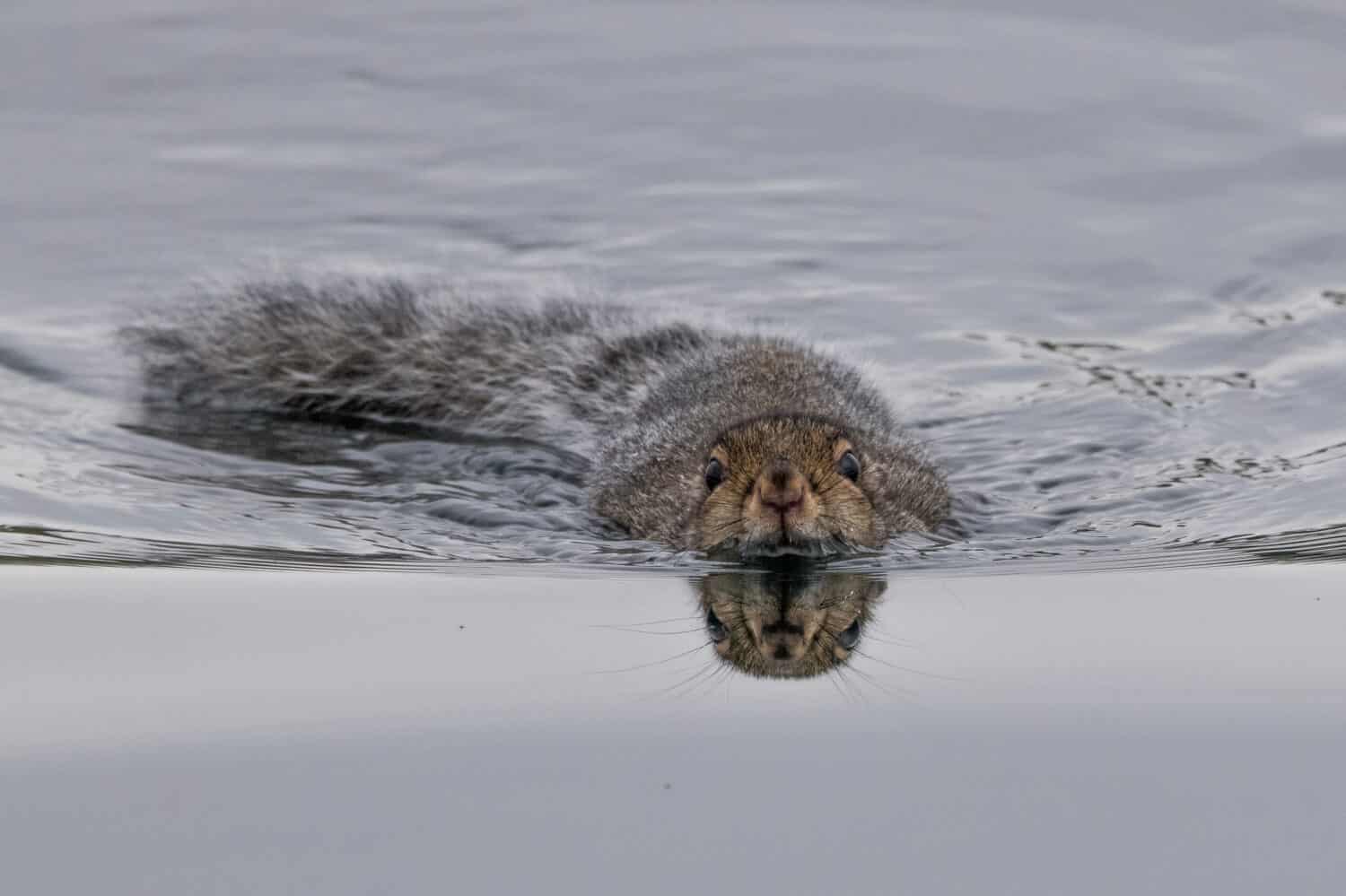Can Squirrels Swim: Surprising Facts About These Agile Swimmers
Have you ever wondered if squirrels can swim? You might picture these agile creatures darting through trees, but what happens when water gets in their way?
Understanding whether squirrels can navigate water could change how you see them—and even how you interact with wildlife around your home. Keep reading to discover surprising facts about squirrels and their swimming abilities that you probably didn’t know before. This might just change your perspective forever.

Credit: www.squirrelcontrol.ca
Squirrel Swimming Abilities
Squirrels are mostly known for running and climbing trees. Few people know that squirrels can swim well. Their swimming skills help them cross rivers and escape danger. Even though they spend most time on land, squirrels can use water as a safe path.
These small animals have natural skills that help them swim without much effort. Their bodies and movements in water show how well they adapt to swimming. Understanding these abilities gives us a better view of squirrel behavior.
Natural Instincts In Water
Squirrels have a built-in sense to swim. They do not need training or practice. When they fall into water, they start paddling to stay afloat. This instinct keeps them safe from drowning. Their strong survival instincts guide their actions in water.
Wild squirrels face many threats, and swimming helps them escape predators. Water is not their main home, but they can use it when needed. This natural ability increases their chances of survival in different environments.
How They Paddle
Squirrels use all four legs to paddle through water. Their front paws move in a circular motion like tiny oars. The back legs push water backward, giving forward motion. This coordinated movement helps them swim quickly.
Their bushy tails act like rudders to steer and balance. This helps squirrels stay on course while swimming. Their fur also traps air, which helps them float. These features make squirrels good swimmers despite their small size.

Credit: a-z-animals.com
Species That Swim The Most
Some squirrel species swim more often than others. Their swimming abilities vary based on their habitat and lifestyle. Understanding which squirrels swim the most helps us learn about their behavior and survival skills.
Swimming is not common for all squirrels. But certain species have adapted to water and use swimming to escape predators or find food.
Tree Squirrels Vs. Ground Squirrels
Tree squirrels spend most time in trees. They rarely swim because they climb to escape danger. Their bodies are built for jumping and climbing, not swimming.
Ground squirrels live on the ground. Some live near water sources like rivers or lakes. These squirrels swim more often to cross water or find food. Their bodies are stronger and better suited for swimming than tree squirrels.
Aquatic Adaptations
Some squirrels have special traits for swimming. Their fur can be water-resistant, helping them stay warm and dry. Strong hind legs help them paddle through water easily.
These adaptations improve their chances of survival. They can escape predators or reach new areas for food. Swimming squirrels show how animals change to fit their environment.
Reasons Squirrels Swim
Squirrels are known for their quick moves on land, but they can swim too. Swimming is not their main skill, but they use it when needed. There are several reasons why squirrels swim. These reasons help them survive and explore their surroundings.
Swimming helps squirrels in tough situations. It is a useful skill for escaping danger, finding food, and moving across water areas.
Escaping Predators
Squirrels swim to escape predators chasing them. Water can be a safe place to hide. Many predators avoid water, so swimming gives squirrels a chance to escape harm. This quick swim can save their lives during attacks.
Searching For Food
Squirrels sometimes swim to find food sources. Some nuts and fruits grow near water. Swimming helps squirrels reach these food spots. They can explore new areas for food by crossing small ponds or streams.
Crossing Water Barriers
Rivers, streams, and ponds can block squirrels’ paths. Swimming allows them to cross these barriers. This helps squirrels reach new places for shelter or mates. It also expands their living area beyond land obstacles.
Swimming Techniques And Behavior
Squirrels are not often seen swimming, yet they can move through water with surprising skill. Their swimming techniques differ from many animals. These techniques help them stay safe and reach places on the other side of a stream or river.
Understanding how squirrels swim reveals much about their behavior and survival methods. They use specific strokes, control their breath well, and show good endurance in water. These skills allow them to handle wet environments effectively.
Stroke Patterns
Squirrels use a dog paddle style to swim. Their front paws move in small circles, pulling water back. The hind legs kick to push the body forward. This pattern keeps their heads above water. It is simple but effective for short distances.
Breath Control
Squirrels hold their breath while swimming underwater. They dive to avoid danger or cross water faster. Their noses close tightly to stop water from entering. They surface regularly to breathe before diving again. This helps them stay calm and swim longer.
Endurance In Water
Squirrels can swim for several minutes without stopping. They are not built for long swims but manage short trips well. Their fur helps keep them warm and buoyant. Staying close to shore or trees gives them quick escape routes.
Surprising Swimming Stories
Squirrels are not just quick climbers and jumpers. Some can swim too. Stories of squirrels swimming surprise many people. These tales come from both wild settings and human encounters. They show a different side of these clever animals. Swimming helps squirrels escape danger or reach food. It is a skill not many expect from them.
Below are some surprising stories about squirrels swimming. They reveal how adaptable and resourceful squirrels can be.
Notable Observations In The Wild
Wild squirrels have been seen swimming across ponds and streams. They use their bushy tails like paddles. This helps them move steadily in water. Sometimes, they swim to cross rivers or escape predators. Researchers have watched squirrels swim for several meters. This shows their survival instinct. Swimming is not their main skill, but they manage well when needed.
Unexpected Encounters With Humans
People often spot squirrels swimming near parks or gardens. Some squirrels dive into pools or fountains. They do this to cool off on hot days. There are stories of squirrels swimming to reach bird feeders on islands. Humans have even rescued squirrels that got tired in water. These moments reveal how squirrels can adapt to urban life. Swimming helps them explore more places safely.
Safety Tips For Squirrels Near Water
Squirrels are curious animals often found near water sources like ponds, streams, and lakes. Water can be both a help and a hazard for them. Knowing safety tips for squirrels near water helps protect these small creatures. It also helps people understand how to act when squirrels face danger in or near water.
Common Hazards
Squirrels can face many dangers near water. Strong currents in rivers or streams can sweep them away. Cold water can cause hypothermia quickly. Deep water can make it hard for squirrels to swim back to shore. Trash or fishing lines can trap or injure squirrels. Predators often wait near water to catch them. These hazards make water risky for squirrels.
How To Help A Stranded Squirrel
Helping a squirrel stuck in water needs care and calmness. Use a towel or cloth to gently pick it up. Avoid direct contact with bare hands to prevent bites. Place the squirrel in a warm, dry box or container. Do not give it food or water right away. Contact a local wildlife rescue for further care. Quick help can save a squirrel’s life.
Comparing Squirrels To Other Small Swimmers
Squirrels are small animals often seen running in parks and forests. Many wonder if squirrels can swim like other small animals. Comparing squirrels to other small swimmers helps us understand their abilities better. Some small creatures are good swimmers. Others avoid water. Let’s see how squirrels match up.
Chipmunks And Swimming
Chipmunks are close relatives of squirrels. They mostly live on land and in trees. Chipmunks can swim if needed. They paddle with their legs to stay afloat. Their swimming skills are not strong but enough to cross small streams. Chipmunks use swimming mainly to escape danger. Unlike squirrels, chipmunks spend more time near water sources.
Mice And Water Survival
Mice are smaller than squirrels and chipmunks. They can swim but usually avoid water. Mice use quick movements to escape water threats. Their tiny size helps them float for short times. Mice swim in a dog-paddle style. They survive in wet places but do not stay long in water. Swimming helps mice survive floods or predators.

Credit: www.nhpr.org
How Smart Pets Lover Can Help You with Can Squirrels Swim
Turning Squirrel Swimming Insights into Learning Moments
Understanding squirrel swimming abilities offers more than just fascinating facts—it opens doors to practical learning for pet parents and animal enthusiasts alike. Observing the reasons squirrels swim and their unique swimming techniques can inspire thoughtful safety measures around water for all small pets. For example, knowing which species swim the most helps us appreciate the adaptability and survival instincts in the animal kingdom, encouraging us to create safer, more enriching environments for our furry friends.
- Encourage supervised exploration near water to build confidence and awareness in your pets.
- Apply safety tips for squirrels near water as a guideline when introducing small pets to swimming.
- Compare their natural behaviors with those of dogs or cats to better understand pet-specific needs.
At Smart Pets Lover, where every wag, purr, and chirp tells a story, we believe these insights nurture a deeper connection with animals. For more tailored advice or questions, feel free to reach out to us at [email protected]. Learning from nature’s swimmers can truly enrich how we care for our companions.
Frequently Asked Questions
Can Squirrels Swim Naturally?
Yes, squirrels can swim naturally. They use a dog-paddle style to move through water. Swimming helps them escape predators and cross obstacles.
How Far Can Squirrels Swim Safely?
Squirrels can swim short distances, usually under 100 feet. They avoid long swims due to exhaustion and risk of drowning.
Do All Squirrel Species Swim?
Not all species swim regularly, but most tree squirrels can swim if needed. Ground squirrels rarely swim as their habitat differs.
Why Do Squirrels Swim Sometimes?
Squirrels swim to escape danger, search for food, or cross water barriers. Swimming is a survival skill, not a common activity.
Conclusion
Squirrels can swim when they need to. Their bodies help them paddle through water. They do not swim for long times though. Mostly, squirrels avoid water but can cross small streams. Swimming helps them escape danger or find food. Watching squirrels swim shows their surprising skills.
Nature gives animals many ways to survive. Next time you see a squirrel near water, remember this fact. It’s a small but smart part of their behavior.





